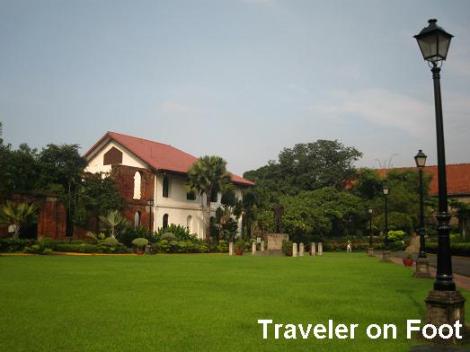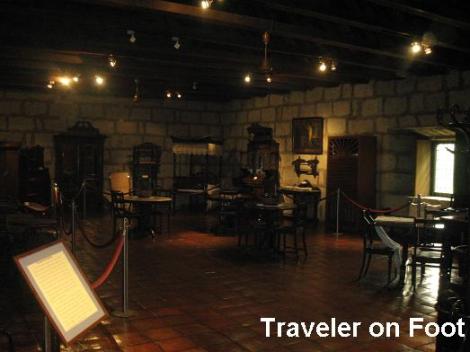The old fortress of the Spanish Empire, Fort Santiago was named after Santiago Matamoro (St. James Slayer of the Moors). Guarding the entrance of the Pasig River from Manila Bay, this formidable fort was built on the site of Rajah Sulayman’s original wooden fort.

Fort Santiago may not be as old as Cebu’s Fort San Pedro (the first and oldest colonial fort built in the country), but it had significantly served as military headquarters of Spain, British, United States and Japan during different eras in our history.
The arched entrances, the silent moats, the dimly-lit tunnels and the solid walls of its dungeons stood witness to the Tales of Death from the Dungeons and Jail Cells of Fort Santiago.
Plaza Moriones
Fort Santiago tour begins at Plaza Moriones, a public promenade until it was fenced off by the Spanish military in 1864. Located at the left side of the park is the Baluartillo de San Francisco Javier. It was built by Governnor Sabiniano Manrique de Lara to protect the old postern gate when the first Governor’s Palace was located inside the fort until 1654. Its chambers stored military supplies. Today, it houses the Intramuros Visitor’s Center.
Baluartillo de San Francisco Javier is adjoined by a tunnel that leads to the Reducto de San Francisco Javier, which now enshrines the image of the Nuestra Señora de Guadalupe.

Before crossing the other side of the plaza, we passed by the American barracks where Ferdinand Marcos was imprisoned.
Across the other side of Plaza Moriones is the ruins of the Almacenes Reales or the Royal Warehouse where the goods brought in by the galleons were stored. A chapel dedicated to the Nuestra Señora de la Encarnacion used to stand at the far end of the Almacenes. It served as chapel for the military and audencia. It was destroyed during a great fire and was never rebuilt.
Passing by the picnic ground is the Artelleria de Maestranza or royal foundry where the Spanish cast cannons and ammunitions. The bronze statue of King Carlos IV at Plaza Roma was cast on the Maestranza.
Plaza Armas

A small bridge over the moat leads visitors to the main gate of the fort. The only original structures at the entrance are the two sentinels located at the sides. The rest were blown up during the 1945 Liberation.
Guarding its flanks were the Medio Baluarte de San Francisco on the river side and Baluarte de San Miguel on the bay.
Plaza Armas was the fort’s main square. It is surrounded by military barracks. To the north side of the plaza was a barracks, which is the probable site of the wooden fort of Rajah Sulayman. On south side are the ruins of a Spanish barracks and building that was reconstructed to house the Rizal Shrine.

A postern leading to Pasig River located at the far north of the plaza called Postigo de la Nuestra Señora de Soledad was used by Governor Simon de Anda to escape from the British when the city was breached.
Near the postern is the chapel cell where Jose Rizal spent the nigh before he was led to his execution.
Baluarte de Santa Barbara
At the far end of Plaza Armas was the residence of the fort’s commander or Casa del Castellano. The dungeon below was the cellar where food supplies were kept. A terraced garden now occupies the site.
Strategically located to overlook the bay and the river, Baluarte de Sta. Barbara was initially built as a wooden platform in 1593. Storage vaults and bomb-proof powder magazines were added in 1599.

A Rizaliana Exhibit featuring the furniture and personal effects of the Rizal family can be viewed from the upper floor of the bulwark.
The Falsabraga de Sta. Barbara and half-moon shaped Media Naranjan were falls walls which protected the main bulwark in case of heavy bombardment form the river.
During World War II, Fort Santiago was renamed Hu Heiei by the Japanese Government. It became the headquarters of the dreaded Kempeitai or Japanese military police who according to legend imprisoned, tortured, drowned and executed numerous Filipinos in the fort’s notorious dungeons.
A memorial cross known as the Shrine of Freedom marks the common grave of approximately 600 bodies of guerillas and civilians found inside the powder magazine of Baluarte de Sta. Barbara.
Information source: Fort Santiago brochure
Click here to begin at Plaza Roma.







I highly recommend that you give Fort Santiago another visit dyosa.
thanks for visiting orly.
may ka date ako dito before…
it has been a while since i visited Fort Santiago. seeing your entry made me think of revisiting this place again. 🙂